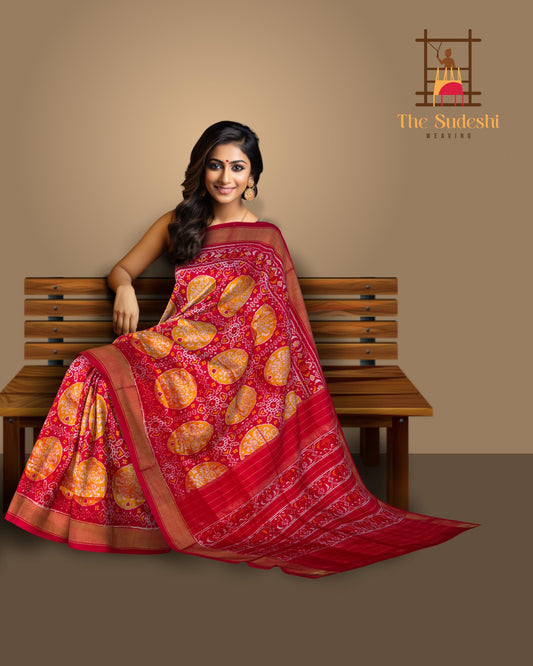Kanchipuram Silk Sarees: A Timeless Reflection of Cultural and Regional Identity
Kanchipuram silk sarees, often referred to as the "Queen of Silks," are not merely garments; they are woven masterpieces that symbolize tradition, elegance, and a deep cultural heritage. Originating from the temple town of Kanchipuram in Tamil Nadu, these sarees have been an integral part of South Indian culture for centuries. But do they merely serve as a fashion statement, or do they hold a deeper meaning related to cultural and regional identity? The answer, without a doubt, lies in the intricate weaving patterns, the choice of colors, and the very essence of how these sarees are perceived.
In this blog, we explore the profound connection between Kanchipuram silk sarees and the expression of cultural or regional identity. We'll dive into their history, craftsmanship, and the cultural significance that continues to influence the choices women make when they drape themselves in these exquisite sarees.
The Origins of Kanchipuram Silk Sarees
To truly appreciate the role Kanchipuram silk sarees play in reflecting cultural identity, it’s essential to first understand their origins. The town of Kanchipuram, located in Tamil Nadu, has been a hub of silk weaving for more than 400 years. The art of weaving silk in this region dates back to the Pallava dynasty, where silk was intricately woven to adorn idols in temples and for use during religious rituals.
Craftsmen from Andhra Pradesh migrated to Kanchipuram and introduced their weaving techniques, blending them with local methods to create what we know today as the Kanchipuram silk saree. The sarees soon became synonymous with royalty, auspiciousness, and regional pride.
Cultural Identity Through Symbolism and Tradition
In many South Indian families, a Kanchipuram silk saree is a wardrobe essential, often passed down through generations as a symbol of heritage. The saree is worn during significant cultural and religious events such as weddings, temple visits, and festivals like Diwali and Pongal. This practice isn’t just about tradition; it’s about expressing one's deep-rooted connection to the culture.
The motifs and designs on Kanchipuram sarees are laden with symbolic meaning. For instance, the traditional "temple border" designs, inspired by the architecture of South Indian temples, evoke a sense of divine connection. Similarly, motifs like elephants, peacocks, and parrots symbolize strength, beauty, and prosperity, respectively. When a woman wears a Kanchipuram saree adorned with such motifs, she’s not just making a fashion statement but also showcasing her connection to cultural and religious ideals.
Regional Identity: The Pride of Tamil Nadu
While Kanchipuram sarees are worn across India, their regional significance is strongest in Tamil Nadu. A Kanchipuram silk saree is more than just a piece of clothing for many Tamil women; it is a symbol of regional pride. The rich hues of red, gold, and green that are often associated with these sarees reflect the vibrancy of Tamil Nadu’s culture. The silk itself is sourced locally, and the craftsmanship is specific to the weavers of Kanchipuram, making it a unique representation of Tamil craftsmanship.
Women often choose Kanchipuram sarees as a way to express their Tamil identity, especially during traditional events. It’s common to see women wearing these sarees during Pongal, the harvest festival that is deeply rooted in Tamil culture, as a way of honoring their ancestors and the land they come from.
The Weaving Process: A Reflection of Craftsmanship and Legacy
The intricate weaving process of Kanchipuram silk sarees is a testament to the artistry that has been passed down from generation to generation. The sarees are handwoven with pure mulberry silk threads and feature real gold or silver zari, making them luxurious yet steeped in cultural meaning. Weaving a single Kanchipuram saree can take anywhere from a few days to several weeks, depending on the complexity of the design.
Each saree is a labor of love, a blend of artistry and tradition. The weavers, many of whom come from families that have been in the trade for centuries, consider their craft a legacy. When a woman chooses a Kanchipuram silk saree, she is not just selecting a garment; she is embracing the history, skill, and culture that the saree embodies.
Kanchipuram Sarees in Modern Times
While Kanchipuram silk sarees are rooted in tradition, their appeal has expanded beyond cultural boundaries. Today, women from all parts of India and even abroad wear these sarees, not just for their traditional significance but for their beauty and craftsmanship. Modern adaptations of the Kanchipuram saree include contemporary color palettes, lightweight variations, and fusion designs that blend traditional motifs with modern aesthetics.
Despite these changes, the saree’s connection to cultural and regional identity remains intact. For many women, particularly in South India, owning and wearing a Kanchipuram silk saree is still a way to honor their roots, uphold their family traditions, and showcase their regional pride.
The Choice of a Kanchipuram Silk Saree: A Personal and Cultural Statement
In the end, the decision to wear a Kanchipuram silk saree is a deeply personal one, yet it is imbued with cultural significance. Whether worn during a wedding, a religious ceremony, or a regional festival, the saree stands as a reflection of the wearer’s cultural and regional identity. The rich silk, the intricate designs, and the vibrant colors tell a story of heritage, tradition, and belonging.
For some, wearing a Kanchipuram saree is a way to stay connected to their roots, to the generations before them who wore these same sarees in celebration of life’s most significant moments. For others, it’s a way to express pride in their Tamil or South Indian identity, showcasing the region’s craftsmanship to the world.
Conclusion
The Kanchipuram silk saree, with its rich history and intricate designs, is more than just a garment. It’s a symbol of cultural pride, regional identity, and personal expression. Every time a woman chooses to drape herself in a Kanchipuram saree, she is embracing centuries of tradition, honoring her heritage, and making a statement about who she is and where she comes from.
In a world where fashion trends come and go, the Kanchipuram silk saree stands as a timeless piece that continues to reflect the culture and identity of the wearer. It bridges the past and present, blending modern style with age-old traditions, making it not just a saree, but a piece of living history.







Leave a comment
Please note, comments need to be approved before they are published.